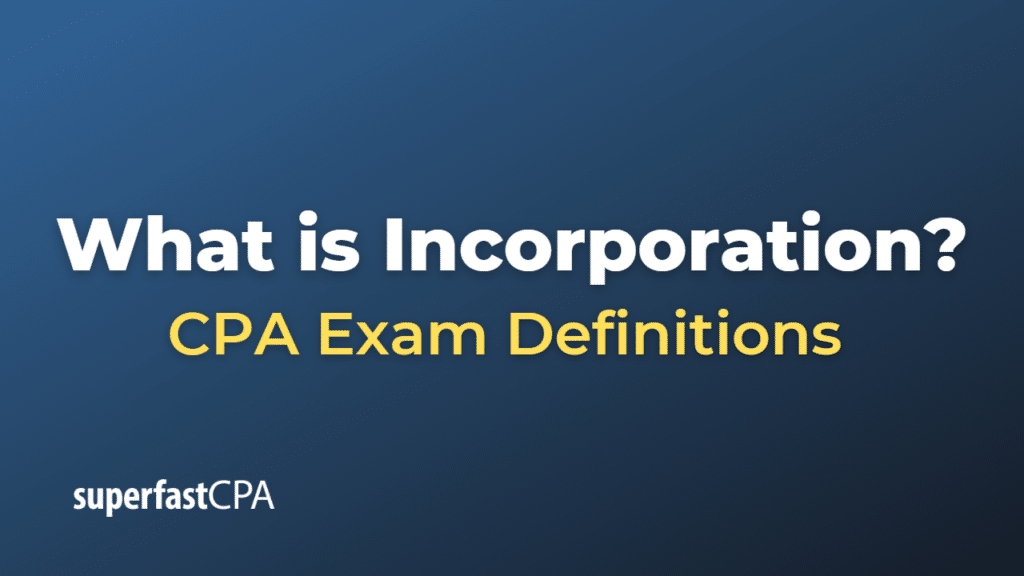Incorporation
Incorporation is the legal process used to form a corporate entity or a company. When a business becomes incorporated, it becomes a distinct legal entity that’s separate from its owners. This means the corporation itself, not the business owners, holds all the business’s assets and liabilities.
Once a company is incorporated, it has all the same rights as a natural person, such as the ability to enter into contracts, own assets, sue and be sued, and even commit crimes.
Incorporation provides a number of benefits, including:
- Limited Liability: Perhaps the most significant benefit of incorporation is limited liability protection. Because a corporation is considered a separate legal entity, the shareholders (the owners of a corporation) are not personally liable for the debts and obligations of the corporation. In other words, if the corporation incurs a debt, only the assets of the corporation are at risk, not the personal assets of the shareholders.
- Perpetual Existence: Corporations can continue indefinitely, regardless of what happens to individual shareholders, directors, or managers. This is known as having a ‘perpetual existence’.
- Easier Access to Capital: Corporations can raise funds by selling shares of stock, which can make it easier for them to raise capital compared to other business structures.
- Transferable Ownership: Ownership of a corporation can be transferred without disrupting operations through the sale of stock.
The process of incorporation involves submitting certain documents—most commonly “Articles of Incorporation”—to the appropriate government department, usually the Secretary of State in the U.S. This document includes key details about the business, such as its name, purpose, initial directors, and share structure.
However, it’s important to note that incorporating a business also involves additional regulations, such as annual reporting requirements, and potentially higher tax burdens in some cases. As such, business owners should consult with legal and financial advisors to choose the best structure for their business.
Example of Incorporation
Alice and Bob are partners in a successful tech start-up that they run as a partnership. After discussing with their advisors, they decide to incorporate their business due to the need for more capital and limited liability protection.
Here’s how they proceed:
- Choose a Name: Alice and Bob choose a unique name for their corporation that hasn’t been taken by another company in their state. They decide on “Tech Innovations, Inc.”
- File the Articles of Incorporation: They then draft and file their Articles of Incorporation with the Secretary of State in the state where they want to incorporate. The Articles of Incorporation include the company name, its purpose, the number of shares they can issue, the address of the initial registered office and agent, and the names of the incorporators.
- Pay Filing Fees: Alice and Bob pay the necessary filing fees required by their state. The amount can vary based on the state of incorporation.
- Create Corporate Bylaws: After the state accepts their filing, Alice and Bob create corporate bylaws, which outline how the corporation will be run. They include information on the roles of directors and officers, meeting schedules, stock details, and other operational procedures.
- Issue Stock: They then issue stock. Alice and Bob each purchase 500 shares (out of a total 1,000 shares) to become the initial owners of the corporation.
- Obtain Necessary Permits and Licenses: Depending on the nature of their business, Alice and Bob ensure that “Tech Innovations, Inc.” obtains any necessary permits and licenses at the federal, state, and local levels.
Now, “Tech Innovations, Inc.” is a separate legal entity. It can own assets, enter contracts, sue and be sued, and has a perpetual existence. Importantly, Alice and Bob’s personal assets are protected from the corporation’s liabilities, and they can more easily raise capital for their business by selling stock.
Remember, this is a simplified example. The actual process can be more complex and often requires legal and financial expertise to ensure compliance with all laws and regulations. Also, incorporation isn’t the best choice for every business. The right business structure depends on many factors, including the nature of the business, its financial situation, and the goals of its owners.













